

What employees are saying about the future of remote work. As organizations look to the postpandemic future, many are planning a hybrid virtual model that combines remote work with time in the office.
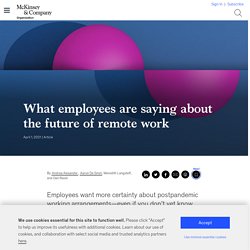
This sensible decision follows solid productivity increases during the pandemic. But while productivity may have gone up, many employees report feeling anxious and burned out. Unless leaders address the sources of employee anxiety, pandemic-style productivity gains may prove unsustainable in the future. That’s because anxiety is known to reduce job satisfaction, negatively affect interpersonal relationships with colleagues, and decrease work performance. Our survey results make the source of anxiety clear: employees feel they’ve yet to hear enough about their employers’ plans for post-COVID-19 working arrangements. As organizational leaders chart the path toward the postpandemic world, they need to communicate more frequently with their employees—even if their plans have yet to solidify fully. Feeling included. Communication breakdown. Share more. Business priorities in the postpandemic era.
This episode of the Inside the Strategy Room podcast features a conversation between Kevin Sneader, McKinsey’s global managing partner, and John Waldron, president and chief operating officer of Goldman Sachs, that took place at our virtual M&A conference in February.
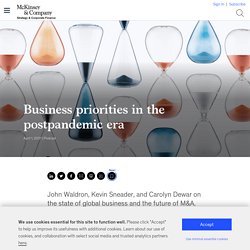
Carolyn Dewar, who co-leads our CEO and board excellence work, moderated their discussion of the current state of mergers and acquisitions, business priorities in the postpandemic era, and how government involvement in the economy may affect future deal making. This is an edited transcript of the discussion. Listen to the podcast episode on Apple Podcasts or Google Podcasts. For more conversations on the strategy issues that matter, subscribe to the series on Apple Podcasts or Google Podcasts.
Kevin Sneader: After the litany of negative things you pointed out, Carolyn, let me start with a note of optimism. There are many other trends to watch. ‘There is an enhanced view that scale matters. Experiments and Data for Post-COVID-19 Work Arrangements. Almost all leaders and employees are wondering what work and business will be like after the pandemic ends.
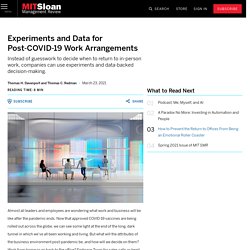
Planning Your Post-Pandemic Future. It feels strange to think about the future from here.
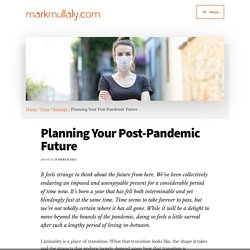
We’ve been collectively enduring an imposed and unenjoyable present for a considerable period of time now. It’s been a year that has felt both interminable and yet blindingly fast at the same time. Time seems to take forever to pass, but we’re not wholly certain where it has all gone. While it will be a delight to move beyond the bounds of the pandemic, doing so feels a little surreal after such a lengthy period of living in-between. Liminality is a place of transition. As we contemplate re-emergence into the world after a protracted period of liminality, there are opportunities to be explored about what that future looks like and how we would like it to unfold. How to Prevent the Return to Offices From Being an Emotional Roller Coaster. As more and more people get vaccinated against COVID-19, leaders and employees are starting to look ahead to a potential return to offices.
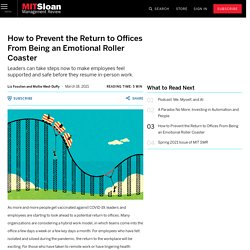
Many organizations are considering a hybrid work model, in which teams come into the office a few days a week or a few key days a month. For employees who have felt isolated and siloed during the pandemic, the return to the workplace will be exciting. For those who have taken to remote work or have lingering health concerns, it will be anxiety-inducing. For many, it will be both. Innovation in a crisis: Your launchpad past COVID-19. Crises are adrenaline for innovation.
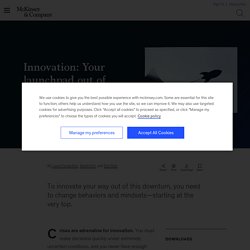
You must make decisions quickly under extremely uncertain conditions, and you never have enough time or information to fully weigh difficult choices that may affect both employee livelihoods and the survival of the business. Yet these very constraints can unleash waves of creativity. Podcast: Workplace Design, Post-Pandemic. ALISON BEARD: Welcome to the HBR IdeaCast from Harvard Business Review.
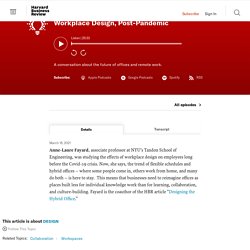
I’m Alison Beard. If you’re like many knowledge workers out there struggling to do your job from home, juggling family responsibilities, exhausted by never-ending Zooms, you might be dreaming of returning to the office when the pandemic ends. Or maybe you really thrived without the daily commute and distracting coworkers, and you want to keep working from home.
The state of corporate restructuring in Europe. As the COVID-19 pandemic continues to threaten lives and livelihoods, many hard-hit European companies face an uncertain future.

Their profitability has declined as a result of significant market disruption during the pandemic. At the same time, they have taken on massive amounts of debt to offset the loss of cash flow. Globally, corporate debt issuance reached a record $5.4 trillion last year (a 20 percent increase from 2019), with another $3.5 trillion from syndicated loans.
European Union data show that European companies added more than €400 billion in debt over the first half of 2020, compared with €289 billion in the whole of 2019. Many struggling organizations will have found some stability through government aid. Your Company Downsized During the Pandemic. Here’s How to Rebuild. At the start of the pandemic, many companies made cuts to personnel costs to make up for declining revenues.
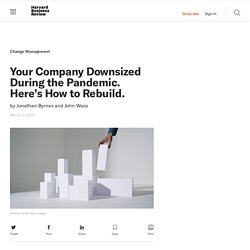
Now, as the recovery begins, many midsize business leaders’ instinct is to rebuild their organizations as they were before. But this is... As companies recover from their pandemic downsizing, they have a golden opportunity — and critical need — to reset their organizations to prosper in the era ahead. How to have a holistic transformation to move past COVID-19. As CEOs look ahead to 2021 and develop their COVID-Exit strategies, one concern looms largest: “How do we get this right?”
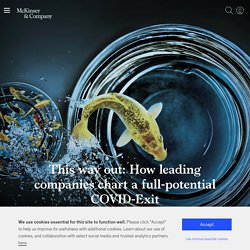
We’ve spoken with multiple CEOs across industries, geographies, and situations, from companies that are still in survival mode, to those that have regained their footing and are ready to leap, to those that have found ways to thrive during this period of unprecedented adversity. Almost to a person, these leaders tell us that they are now looking to hit the right trajectory out of the pandemic, and make the right COVID-Exit.
Audio. 7 Ways to Save Your Working Moms Before It's Too Late. Story Highlights Women's wellbeing slipped as their levels of stress and worry roseThe workforce has lost over 2 million women since the pandemic beganLeaders can set the tone for working moms with these seven things The pandemic changed everything. And while the future of the traditional "8-to-5 workplace schedule" is uncertain, there are both positives and negatives regarding the new approach to getting work done. One of those negatives is that the workforce is currently down 500,000 more women than men compared with before the pandemic began.
Download Prosper: Create the Life You Really Want, 2nd Edition. Prosperity is often associated with your financial wellbeing, but it's so much more than that. Money is a tool to unlock freedom in your life, but it's not capable of giving you fulfillment in the long-term. If you chase money, there's a chance you could lose your relationships or end up with a job you absolutely hate. Ethan Willis and Randy Garn have seen this play out time after time with clients who've lost sight of their guiding inner light—that Polaris Point—or who've never taken the time to establish one in the first place. In Prosper, Ethan and Randy lay out six practices that will guide you to your Polaris Point and lead you down the path to true prosperity. This step-by-step guide shows you how to create the life you really want, one where you've achieved balance between making money, doing what you love, and ensuring it's sustainable.
Three steps to the “best next” workplace. “I can’t wait to get everyone back to the office!” “I’m never going to need an office again!” From these two extremes to a thousand variations in between, leaders are thinking about what work will look like once a critical mass of the population has been vaccinated against COVID-19. Much of the conversation focuses on what we will do: where we will work and how much flexibility will be permitted (or demanded). A richer, more important question is how we will be with one other as post-pandemic routines emerge. The coronavirus has been horrific in terms of deaths, suffering, and disruption to people’s lives.
To lead your organization into its ideal future, you’ll need to create the space for open, honest conversations so you can harvest wisdom from your people and learn from the pandemic. Declare yourselves. Strategy acceleration. In this episode of the Inside the Strategy Room podcast, co-authors of two recent articles—on growth strategies during downturns and the acceleration of trends since the pandemic’s start—help shed light on the reasons behind the widening gap in corporate performance and how companies can position themselves to be among those gaining ground.
Rebecca Doherty is a global leader in our growth and innovation practice and serves healthcare, industrial, and technology clients. Nicholas Northcote is a partner currently on a research fellowship focused on corporate growth and setting strategy during the coronavirus pandemic. He was a major contributor to our recent book, Strategy Beyond the Hockey Stick, upon which some of this podcast is based. This is an edited transcript of the discussion. For more conversations on the strategy issues that matter, subscribe to the series on Apple Podcasts or Google Play. Sean Brown: What were some of your main findings? Sean Brown: Let’s switch to M&A. 2021 is the bridge to returning to normal. We hope that 2021 will see the United States gain a decisive upper hand in its fight against COVID-19. The country is currently engaged in an unprecedented race to vaccinate as many people as possible while using public-health measures to minimize deaths in the short term.
The situation is dire—more people died in the United States from COVID-19 in January 2021 than died in the last two years from the flu. Even as we work through the challenges of this ongoing tragedy, we argue that it is reasonable to hope that the first half of 2021 can be a bridge to what we term “normalcy”—when many aspects of social and economic life can resume without fear of excess mortality (when overall mortality exceeds its long-term average). The great news is that vaccines appear effective—seeing “shots go into arms” is heartening. Report: Designing for adaptive work post COVID-19. Tools such as organizational network analysis (ONA) can provide insights into less visible but arguably more important informal networks within the organization.
Redesigning the Post-Pandemic Workplace. Topics Frontiers. The future of work after COVID-19. The Future of Work Post Covid-19. Report: Reimagining the way businesses operate. Video Special Report. Will the C-suite empty out in 2021? Humanity, Innovation and Radical Progress in the post-COVID World. Those gains could be game changers for individuals who feel left behind or inhibited from jumping into opportunities by the fast pace of change. The corporate center: Driving the next normal. Post–COVID-19: Trust in the workplace.
Business leaders have been rethinking and changing their office spaces, but have they considered how workers have changed? Organizations recognizing their workforce’s evolution and developing reentry strategies based on trust can make the return safe and satisfying. The next normal arrives: Trends that will define 2021—and beyond. Crisis management team: the 5 roles you’ll need in the future. 1. La gestion du changement en entreprise - retour au travail post-pandémie - Capsule-conseil #1. On demand webinar - Creating employee experience for the ‘new normal’ This way out: How leading companies chart a full-potential COVID-Exit. What’s next for remote work: An analysis of 2,000 tasks, 800 jobs, and nine countries. How COVID-19 is redefining the next-normal operating model. Getting Past the Pandemic.
What’s next for remote work: An analysis of 2,000 tasks, 800 jobs, and nine countries. Reimaging a workplace: how to build a community during a pandemic. Reimagining the way businesses operate. Report: The age of agility: Flexible, adaptable and resilient benefits’ 2020/21 report. Post–COVID-19: Trust in the workplace. When nothing is normal: Managing in extreme uncertainty. Your organization is grieving—here’s how you can help. Contrer la lassitude des télétravailleurs. Coronavirus: How the world of work may change forever. How To Accelerate Digital - Accelerating Digital. Companies Need to Stop Pretending It’s Business as Usual. The postpandemic workforce: Responses to a McKinsey global survey of 800 executives. Vers un tout nouveau monde du travail? Podcast: Change Scenarios – What Will the New Normal Look Like Post-Corona Crisis? – With Melanie Franklin. How to Lead in the New Reality of 2020. Communicating with employees during re-entry.
Reimagining the postpandemic economic future. Leading in the New Reality. The office, as you know it, is dead. It’s Time to Get Comfortable Leading in a Crisis. Corporate Purpose and the Great Reset. Igniting individual purpose in times of crisis. Is Your Organization Ready for Permanent WFH? An Epidemiologist on How to Plan a Return to the Office. Reimagining the Urban Office. Three important questions for the future of remote work. Emerging faster and stronger – building blocks of the “new normal” operating model. Emerging faster and stronger – organizing to win the upturn. Fighting COVID-19 and Restarting the Economy Safely. Exploring the Major Ramifications of the Sudden Shift to Remote Work.
Managing the next phase of the COVID-19 Crisis. Influence model and shifting mindsets during COVID-19. Comment bien réseauter en période de pandémie? What New Normal Should We Create? The Next Normal: Business transformation in 2020 and beyond. Socially Conscious Leadership in Today’s Challenging World. Bain & Company. Despite The Pandemic, Employee Engagement is Skyrocketing. Research: Impact of COVID-19 on Employee Engagement. 4 Factors for Sustainable Work Arrangements. Podcast - Collaborating during COVID-19. How companies can make remote working a success. How to Prepare Yourself for a Return to the Office. Roadmap to the new normal. The “New Normal” Is a Myth. The Future Won’t Be Normal at All. Help Your Employees Manage Their Reentry Anxiety. Psychological-safety leadership in a time of flux.
COVID-19: Strategies for the new normal. Report: Facing the future and learning from the past. Report: Preparing for the new normal. Report: Understanding Today and Tomorrow: The Transient Normal. Looking Ahead: The Pandemic and the Future of Work: Part II. Looking Ahead: The Pandemic and the Future of Work: Part I. How leaders can communicate during COVID-19 recovery. COVID-19 and the employee experience. Special Edition: How to Reopen. 3 Non-Obvious Workplace Changes That Will Occur Because Of Covid-19. Change Management Strategies For Getting Back To Work: 10 Ways To Ensure Success. Reset Your Business Strategy in COVID-19 Recovery. 10 ways COVID-19 Is transforming government. Innovation in a crisis: Why it is more critical than ever. Record Covid-19 Cases in the South and West Could Put Economic Recovery at Risk. Podcast/Webcast: 'Only Forward - A Multi Disciplinary Conversation' How CEOs Can Win the Fight and Transform to Win the Future.
Post-Corona: What Management Posture Do You Wish For? 9 Future of Work Trends Post-COVID-19. 5 ways COVID-19 has changed workforce management. Scorecard: Ready to restart your business in the Low Touch Economy?